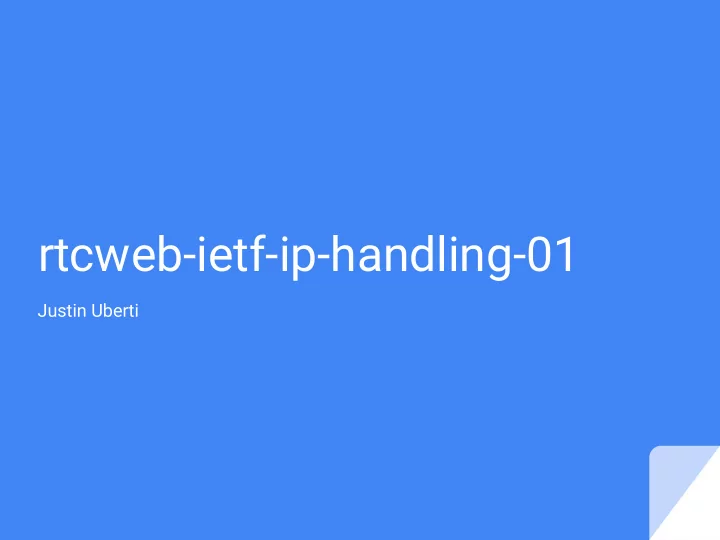

rtcweb-ietf-ip-handling-01 Justin Uberti
Refresher: Goals Prevent drive-by address harvesting, especially ISP IP when using VPN ● ● Avoid degrading user experience or quality by default ● Provide options to prevent exposure of local IP addresses and force use of proxy in specific cases
Refresher: 4 Modes 1. Everything (default, with consent) 2. Restricted gathering, single host candidate (default, no consent) 3. Restricted gathering, no host candidates (via prefs or extension) 4. Force proxy (via prefs or extension)
Changes from individual draft Detailed reviews by Adam Roach and Wendy Seltzer (thanks!) ● ● Revamped controversial section on coupling IP gathering permission with cam/mic permission ● Discussion of proxies now considers non-TCP and RETURN proxies Added necessary references ● ● Various editorial changes
IP Gathering Permission Old New WebRTC incorporates an explicit permission grant for access When used with audio and video devices, WebRTC requires to local audio and video, which are typically much more explicit user permission to access those devices. We propose sensitive than the aforementioned IP address information . If that this permission grant be expanded to include consent to the user has consented to media access, this should also allow WebRTC to access all IP addresses associated with the allow WebRTC to gather all possible candidates and determine user agent, for the purpose of finding the absolute best route the absolute best route for media traffic. for media traffic. Combining these permission grants, rather than having the user grant permission individually, is a considered balance ; this balance takes into account that the user has placed enough trust into the application to allow it to access their devices, that when doing so the user typically wants to engage in a conversational session, which benefits most from an optimal network path, and lastly, the fact that the underlying issue is complex, and difficult to explain meaningfully to the user.
Proxies Force proxy mode was previously called "Force TCP and proxy" ● ● Adam argued that this was overly restrictive, as one could potentially have a UDP proxy (SOCKS5 or RETURN) ● Text changed to consider UDP proxies, and mention that the performance implications are not as dire in these (currently rare) cases ● One noteworthy difference with UDP proxies is that the proxy can be used even in Restricted Gathering scenarios (i.e. not just Force Proxy)
HTTP/SOCKS Proxy Behavior Restricted gathering + host Restricted gathering, no host Force proxy External App External App External App Client TURN Client TURN Client TURN NAT HTTPS NAT HTTPS NAT HTTPS Proxy Proxy Proxy Internal Internal Internal Browser Browser Browser Client Client Client
RETURN Proxy Behavior Restricted gathering + host Restricted gathering, no host Force proxy External App External App External App Client TURN Client TURN Client TURN NAT RETURN NAT RETURN NAT RETURN Proxy Proxy Proxy Internal Internal Internal Browser Browser Browser Client Client Client
Open Issue: RFC 2119 Language Is this a standards-track doc? ● ● If standards-track, shouldn't it be more prescriptive? ● Harald suggests: yes and yes , e.g.: Old: "We recommend Mode 1 as the default behavior only if cam/mic permission has been granted, or Mode 2 if this is not the case." New: "WebRTC implementations MUST implement Modes 1 and 2. Mode 2 SHOULD be the default behavior, with Mode 1 only activated if the user has granted permission."
Next Steps Resolve wording issue and publish new version ● ● Additional reviews? ● WGLC?
Recommend
More recommend